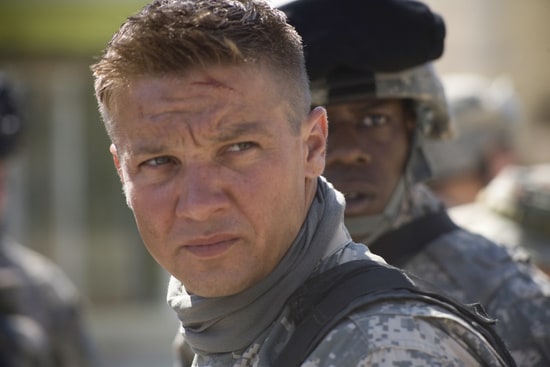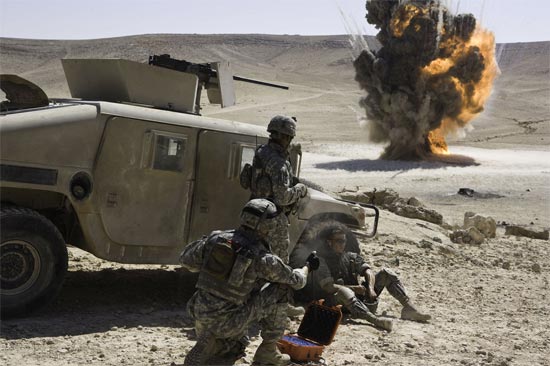The notion of yet another motion picture concerning the Iraq War is probably about as welcome as a knife in the eye. While it may be a pertinent topic in this day and age, it's a flat cinematic subject, with Hollywood producing generally stodgy movies of bloated self-importance marred by various miscalculations (Rendition, The Kingdom, and so on). Thank heavens, then, for Kathryn Bigelow's superb The Hurt Locker. Among the various reasons that Bigelow's flick works where others have failed is that it never endeavours to be "about" the war in Iraq; rather, it accepts the war as a background setting for a fascinating character study regarding the potentially addictive thrills of mortal danger.

Set during the early stages of the post-invasion period in Iraq in 2004, The Hurt Locker follows a group of American soldiers known as Bravo Company who specialise in bomb disposal. With just a few weeks remaining before they are rotated back to the United States, their Sergeant meets with an unfortunate end. This leaves the other soldiers in the unit to serve their final weeks with a new comrade; Staff Sergeant William James (Renner). Much to the chagrin of his fellow soldiers, James is an adrenaline junkie with no qualms about disarming a bomb device manually (and thus breaking protocol). The plot of The Hurt Locker from there is episodic, with the soldiers shifting from conflict to conflict. Tension is a killer during these sequences, because explosive devices aimed at everyone and no-one could be disguised beneath any pile of garbage. Since a bomb would take out anybody and anything within a certain radius, James must approach one of the devices alone to disarm it (with the perimeter maintained by his fellow soldiers). Thus, one of the most repeated images of the film is of the unaccompanied James as he wanders into a strangely deserted space - a fitting visual metaphor for the character's emotional and personal isolation from those around him, both near and far (one even gets the sense his wife and kid back home are never close in his mind).
The Hurt Locker was scripted by Mark Boal; a journalist who based the film's screenplay on his own experiences. Even if you're unaware of this fact before watching the movie, you'll likely suspect it because a clear and unvarnished sense of reality permeates every frame. This is an apolitical, boots-on-the-ground war picture. Not once do the characters stop to discuss why they are there, and they never discuss the wayward politics of the war. In fact, the movie has no political agenda. The filmmakers don't care if the invasion and occupation is right or wrong - all that matters is that the troops are in the country, have a job to do, and are fighting for survival. Much like a number of prior films that have touched on the Iraqi conflict (such as Jarhead), The Hurt Locker portrays a meandering battle that ends up being less about specific offenses and more about maintenance. Unpredictable combat leads to unpredictable schedules, and (particularly for a bomb disposal unit) the call of duty comes when it comes. Right from the opening scene, there's a potent sense that no character is safe, and death can come at any moment. It's this terrifying uncertainty that fuels the story's drama.

Another of the greatest strengths of The Hurt Locker is that it quickly and decisively re-establishes Kathryn Bigelow's position as one of the best action filmmakers in the business. Speaking from a technical standpoint, this film is a stunner from start to finish. Bigelow has always had a knack for directing action in complicated, even abnormal scenarios (like surfers robbing banks in Point Break), and the deserts of Iraq are no different, with the director exhibiting an amazing command for the physical details of filmmaking while shifting through the various set-pieces. A viewer can viscerally feel the danger the characters are in, as most of the film was shot on location in Jordan using an effective documentary style. Interestingly, cinematographer Barry Ackroyd utilised four handheld cameras at any one time, capturing a total of about 200 hours of footage. Even with this handheld disposition, the frame is never rocked too much. However, it must be said that despite this technical competency, the movie fails to resonate as much as something like Saving Private Ryan or Platoon.
The film's cast boasts such names as Ralph Fiennes, Guy Pearce and David Morse, but these big-name actors are relegated to minor roles. This is intentional since, although these well-known stars may entice people to watch the movie, they can detract from the reality of the situation. The main players of The Hurt Locker are instead Jeremy Renner, Anthony Mackie and Brian Geraghty, each of whom pulls off their characters with complete assurance and compelling enthusiasm.

Kathryn Bigelow's The Hurt Locker is not a film that assumes an ideological stand regarding the Iraq War. Instead, it aspires to present viewers with a war film about the ways in which a unit of soldiers react to the pressures of combat. In fact, if a few details were changed, this could be set during any war. To the credit of the filmmakers, the movie only misfires a few times - a major detractor is when the focus leaves Iraq on a couple of occasions to examine William James' life in America, but neither time is necessary. The second trip home provides an explanation for James' risky behaviour that's a bit too on the nose, especially when combined with the music video-style recruitment commercial that closes the film.
8.7/10
 Login
Login